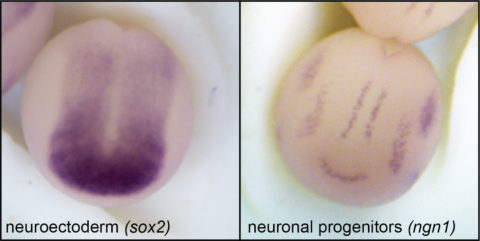Influence of substrate stiffness on early neural development
The central nervous system (CNS) arises from the so-called neurogenic ectoderm, which is specified in embryonic development around the time of gastrulation. From this tissue, both the central nervous system with all its neuronal and non-neuronal cells, as well as the neural crest and its derivatives, emerge.
During early neural development, the central nervous system, i.e. the brain and spinal cord emerges from the neurogenic ectoderm. The initially flat neural plate undergoes morphogenesis to form the neural tube, which is further patterned along the anterior-posterior and dorso-ventral axis. When the neural tube has closed, the CNS consists of the three primary brain ventricles and the spinal cord.
I investigate the effects of substrates (hydrogels) with different mechanical properties on the early patterning and differentiation of organoid models of early brain development in terms of the gene expression of neural, neuronal, and neural crest-specific marker genes.
(Master Thesis M. Mager)
